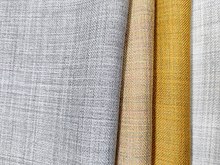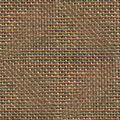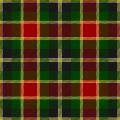Piece goods

Piece goods were the textile materials sold in cut pieces as per the buyer's specification. The piece goods were either cut from a fabric roll or produced with a certain length, also called yard goods. Various textiles such as cotton, wool, silk, etc., were traded in terms of piece goods. The prices were determined as per the fabric quality.[1][2][3][4][5]
Production[]
Many Indian clothes were ready to wear after leaving the loom. These were simple pieces of cloth of dimensions suited to the purposes. Lungi, Dhoti, and Sari are few specific examples of drape clothes. Other cloths produced according to specified dimensions are:
- Longcloth made at Coromandel Coast was of the length of 37 yards[6] or 37 to 40 yards.[7]
- Qutni at Damascus was weaved as per market specified dimensions; for example, Length 6.13 meters width 0.7 meters was for Syria, Baghdad and Constantinople, Smyrna, and Persia. But for Egypt, the length was slightly more, i.e., 6.83 with the same width.[8]
- Chautar an old muslin has been recorded with specific dimensions, i.e., length 12.44 meters and width 77.75 centimeters. Chautar was compared with sansuo, which was a three shuttle cloth, type of fine cotton variety produced at Songjiang.[9]
- Tasar, a silk and cotton cloth used for lining in quilts from Bengal was produced with 14 yards of length and 1.5 yards width.[10]
- Alachas were 5 yards long.[11]
- A type of Gulbadan (silk cloth), Sohren Gulbadan was with 36 feet long and 1 foot and 4 inches wide.[12][13]
- Salampore was 16X1 yards.[14]
- Sussi (cloth) a striped fabric was 10 to 20 yards long and one yard in wide.[15]
- Khasas were having dimensions of 20 x 1 or 1.5 yards. The number of threads was in warp direction were 1400-2800 with the weight of 595 grams /pc (with 2800 threads).[16]
- Mulboos khas special muslins, reserved for royal aristocracy were measured 10 yards X 1-yard when produced of half-length. They were having 1800-1900 threads in warp.[17]
- Man-cheti was a “ginger yellow” cotton cloth made in India in the 14th century. Made in lengths of fifty feet and a width of four feet.[18]
Trading practices[]
Textile piece goods have been sold globally in many varieties, including grey, bleached, or dyed and prints.[19][20] And the practice is still being followed by many buyers. The knitted fabric is traded by weight also.
History[]
Historically drapers and cloth merchants were trading in piece goods. India was famous for its handloom cotton piece goods. Many fabrics of coarse to fine cotton qualities such as Baftas, calicos, and muslins were used to be exported during the Mughal era.
There are records stating that in 1664 the East India Company imported 273,746 pieces of cotton cloth from India (approximately 4.2 million sq. meters). This increasing trend finally peaked in 1684 at 1,760,315 pieces (or 26.9 million sq. meters).[21][22] Woolen and silk piece goods were also traded.[23][24][3][25][26]Woollen piece goods for example shawls were exported from Kashmir.[27]
The exports were continued until the British cloths emerged in the 19th century.[28]
During the 1920s, the Philippines was the largest market for cotton piece goods exported by the United States of America.[29]
Currently[]
Several textile piece goods are still traded with different HS codes to differentiate the weave, structure, and composition. For example, HS code 51123030 stands for hundred percent wool, and 58109100 is for woven dyed cotton with embroidery piece goods. The Harmonized System, or ‘HS,’ is an identification code developed by the World Customs Organization (WCO).[30][31]
See also[]
- Mercery
- Bolt (fabric)
- Greige goods
- Drapery
- Draped garment
- kilts
- Belted plaid
- Chiton (costume)
- Loincloth
- togas
- stolas
- saris
- sarongs
- lungis
- pareos
- Longyi
- Dhoti
- Poncho
- Cloak
- Shawl
References[]
- ^ "Definition of PIECE GOODS". www.merriam-webster.com. Retrieved 2020-12-21.
- ^ Wingate, Isabel Barnum (1979). Fairchild's dictionary of textiles. Internet Archive. New York : Fairchild Publications. p. 455. ISBN 978-0-87005-198-2.
- ^ a b Chaudhury, Sushil (2020-03-10). Spinning Yarns: Bengal Textile Industry in the Backdrop of John Taylor's Report on 'Dacca Cloth Production' (1801). Routledge. ISBN 978-1-000-07920-3.
- ^ Blanco, A. E. (2019-11-29). Piece Goods Manual: Fabrics described; textile, knit goods, weaving terms, etc., explained; with notes on the classification of samples. Good Press.
- ^ Office, United States Patent (1925). Annual Report of the Commissioner of Patents. U.S. Government Printing Office. p. 1686.
- ^ Peck, Amelia (2013). Interwoven Globe: The Worldwide Textile Trade, 1500-1800. Metropolitan Museum of Art. p. 305. ISBN 978-1-58839-496-5.
- ^ Rømer, Ludvig Ferdinand; Mer, Ludewig Ferdinand R. (2000). A Reliable Account of the Coast of Guinea (1760). British Academy. p. 266. ISBN 978-0-19-726218-4.
- ^ Issawi, Charles (1988-07-14). The Fertile Crescent, 1800-1914: A Documentary Economic History. Oxford University Press. p. 383. ISBN 978-0-19-536421-7.
- ^ Ray, Haraprasad (1993). Trade and Diplomacy in India-China Relations: A Study of Bengal During the Fifteenth Century. Radiant Publishers. p. 89. ISBN 978-81-7027-202-1.
- ^ Sangar, S.P. (1969). "Silk Cloth in the 17Th Century". Proceedings of the Indian History Congress. 31: 233–240. ISSN 2249-1937. JSTOR 44138372.
- ^ Forming ... to the hand-book of the economic products of the Punjab. Engineering College Press. 1872. p. 66.
- ^ FOUND INSIDE – PAGE 222 ''Sohrén gulbadan is made in pieces 36 feet long by 1 foot 4 inches wide . The ground is scarlet with thin yellow and green lines . It is made either of silk or cotton , and is in common use for shirts and trousers among the women of all classes ...'' Baluchistan District Gazetteer Series - Volume 6 - Page 222books.google.co.in › books Baluchistan (Pakistan) · 1907
- ^ ''These are often of dark green crepe with a red border . c ) Sohren gulbadan is made in silk or cotton pieces ( 36 feet x 16 inches ) . The material is scarlet with thin yellow lines . This material is used for shirts and trousers among all classes of ...'' Papers of the Peabody Museum of Archaeology and Ethnology, ...books.google.co.in › books 1954 ·https://www.google.co.in/books/edition/Papers_of_the_Peabody_Museum_of_Archaeol/8mOaDpv505MC?hl=en&gbpv=1&bsq=sohren+gulbadan&dq=sohren+gulbadan&printsec=frontcover
- ^ Montgomery, Florence M. (1984). Textiles in America 1650-1870 : a dictionary based on original documents, prints and paintings, commercial records, American merchants' papers, shopkeepers' advertisements, and pattern books with original swatches of cloth. Internet Archive. New York ; London : Norton. p. 339. ISBN 978-0-393-01703-8.
- ^ Montgomery, Florence M. (1984). Textiles in America 1650-1870 : a dictionary based on original documents, prints and paintings, commercial records, American merchants' papers, shopkeepers' advertisements, and pattern books with original swatches of cloth. Internet Archive. New York ; London : Norton. p. 349. ISBN 978-0-393-01703-8.
- ^ Chaudhury, Sushil (2020-03-10). Spinning Yarns: Bengal Textile Industry in the Backdrop of John Taylor's Report on 'Dacca Cloth Production' (1801). Routledge. ISBN 978-1-000-07920-3.
- ^ Chaudhury, Sushil (2020-03-10). Spinning Yarns: Bengal Textile Industry in the Backdrop of John Taylor's Report on 'Dacca Cloth Production' (1801). Routledge. ISBN 978-1-000-07920-3.
- ^ Kumar, Raj (2008). Encyclopaedia of Untouchables Ancient, Medieval and Modern. Gyan Publishing House. p. 227. ISBN 978-81-7835-664-8.
- ^ Administration, United States Office of Price (1943). Press Releases. p. 334.
- ^ Dillon, Michael (2008-08-07). Chinese Economic History up to 1949 (2 vols). Global Oriental. ISBN 978-90-04-21786-7.
- ^ Chaudhuri, Trading World, Table C.14, p. S47
- ^ Richards, John F. (1995). The Mughal Empire. Cambridge University Press. p. 198. ISBN 978-0-521-56603-2.
- ^ Mann (F.S.S.), James A. (1860). The Cotton Trade of India: A Paper Read Before the Royal Asiatic Society, London, 21st January, 1860. Harrison and Sons, St. Martin's Lane, W.C. p. 7.
- ^ The British Trade Journal. Benn Brothers. 1889.
- ^ Malani, K. P. Sipahi; Soni, Hans Raj (1936). Indian Economics: A General Survey of Indian Economic Problems. Nand Kishore.
- ^ Burnell, A. C.; Yule, Henry (2018-10-24). Hobson-Jobson: Glossary of Colloquial Anglo-Indian Words And Phrases. Routledge. ISBN 978-1-136-60332-7.
- ^ commerce, India dept of finance and (1880). Review of the trade by land of British India with foreign countries [afterw.] Review of external land trade.
- ^ Stein, Burton (2010-02-04). A History of India. John Wiley & Sons. p. 215. ISBN 978-1-4443-2351-1.
- ^ Hiram Nones (1932), Philippine Cotton Piece-goods Market, Washington: US Government Printing Office
- ^ "Import Data and Price of textile piece goods under HS Code 5112 | Zauba". www.zauba.com. Retrieved 2020-12-21.
- ^ "Export Data Of Textile Piece Goods Under HS Code 5810 | Textile Piece Goods Export Data Of India". www.indiatradedata.com. Retrieved 2020-12-21.
| Look up piece goods in Wiktionary, the free dictionary. |
- Textiles
- Textile industry


